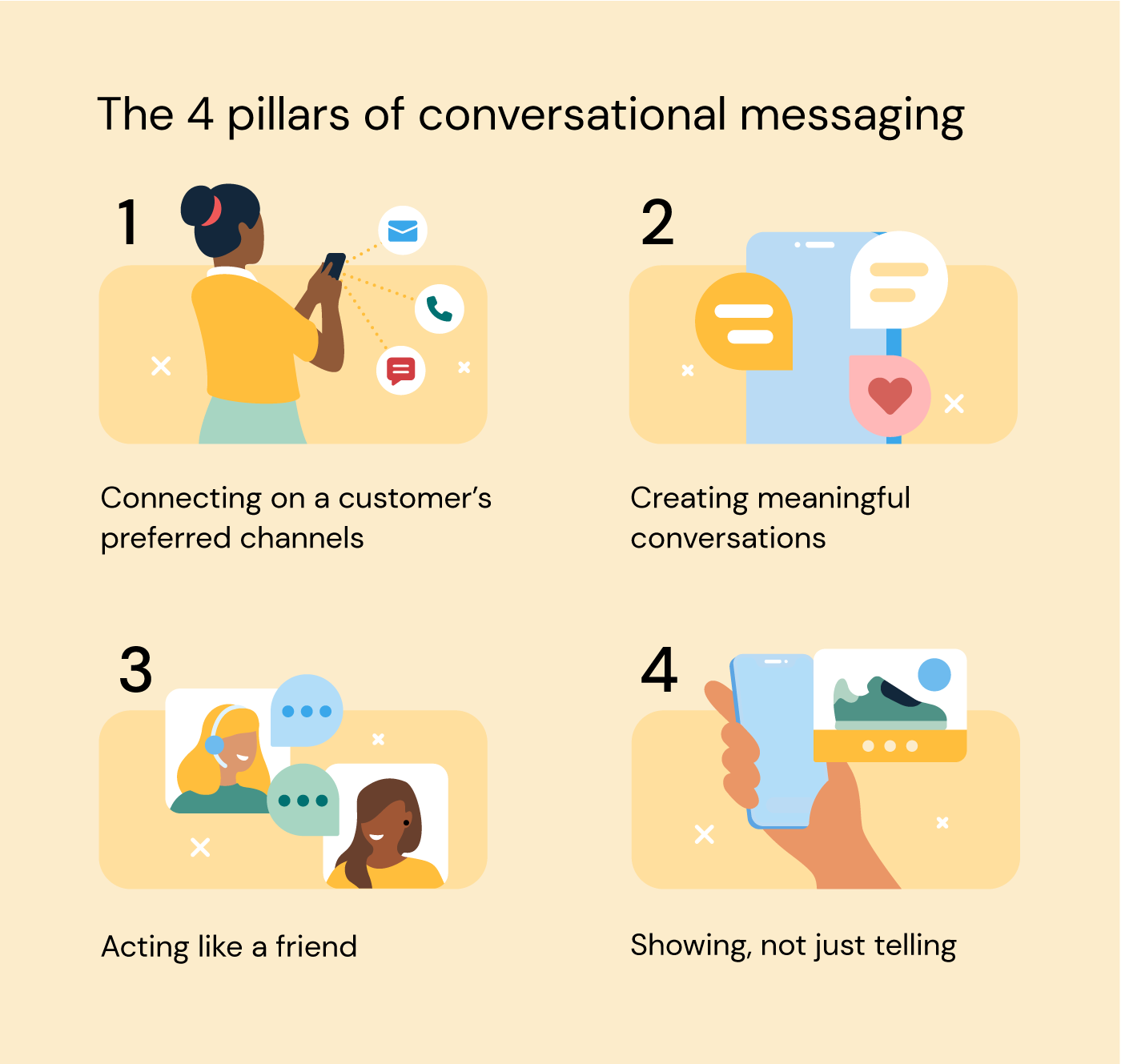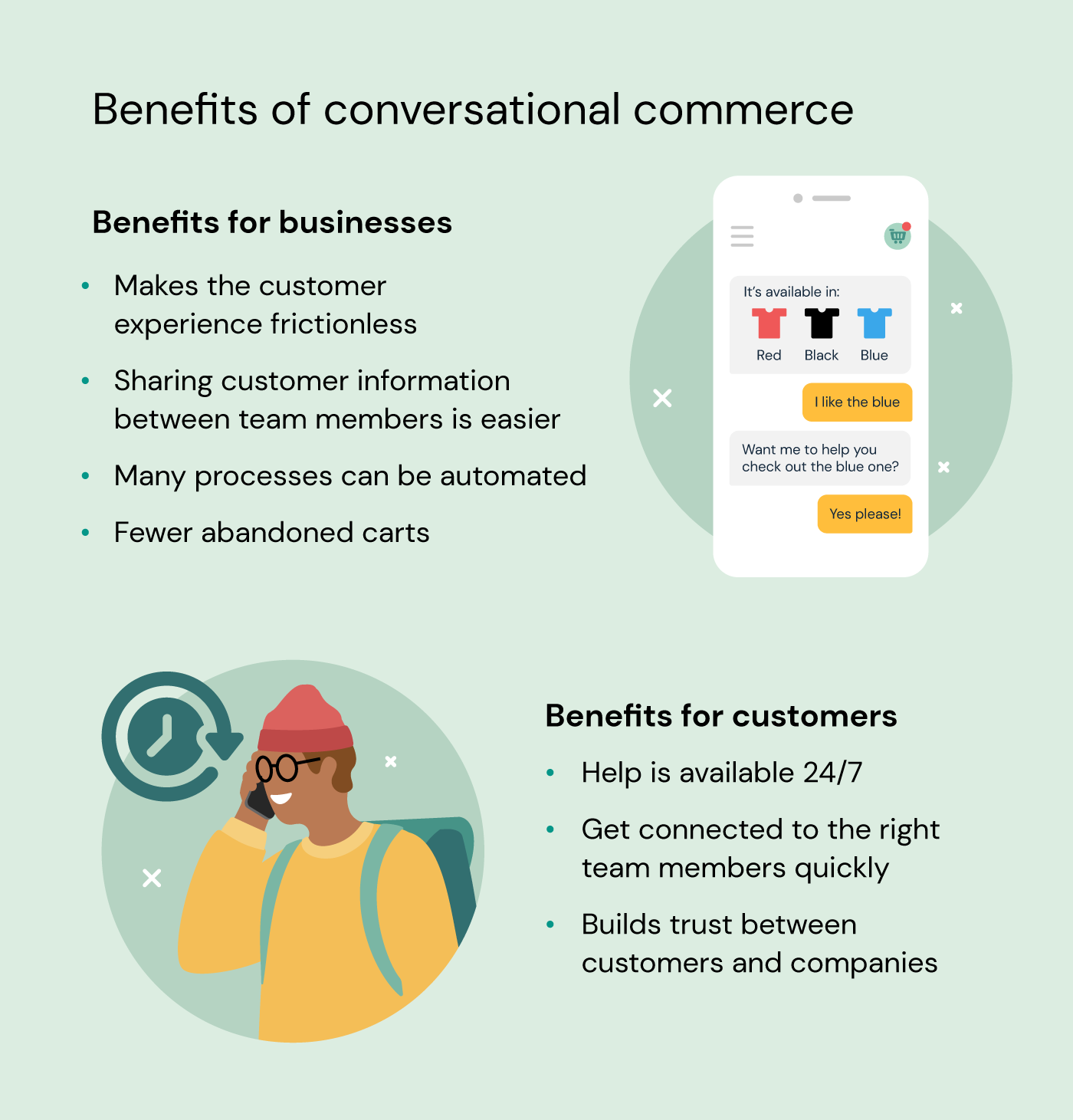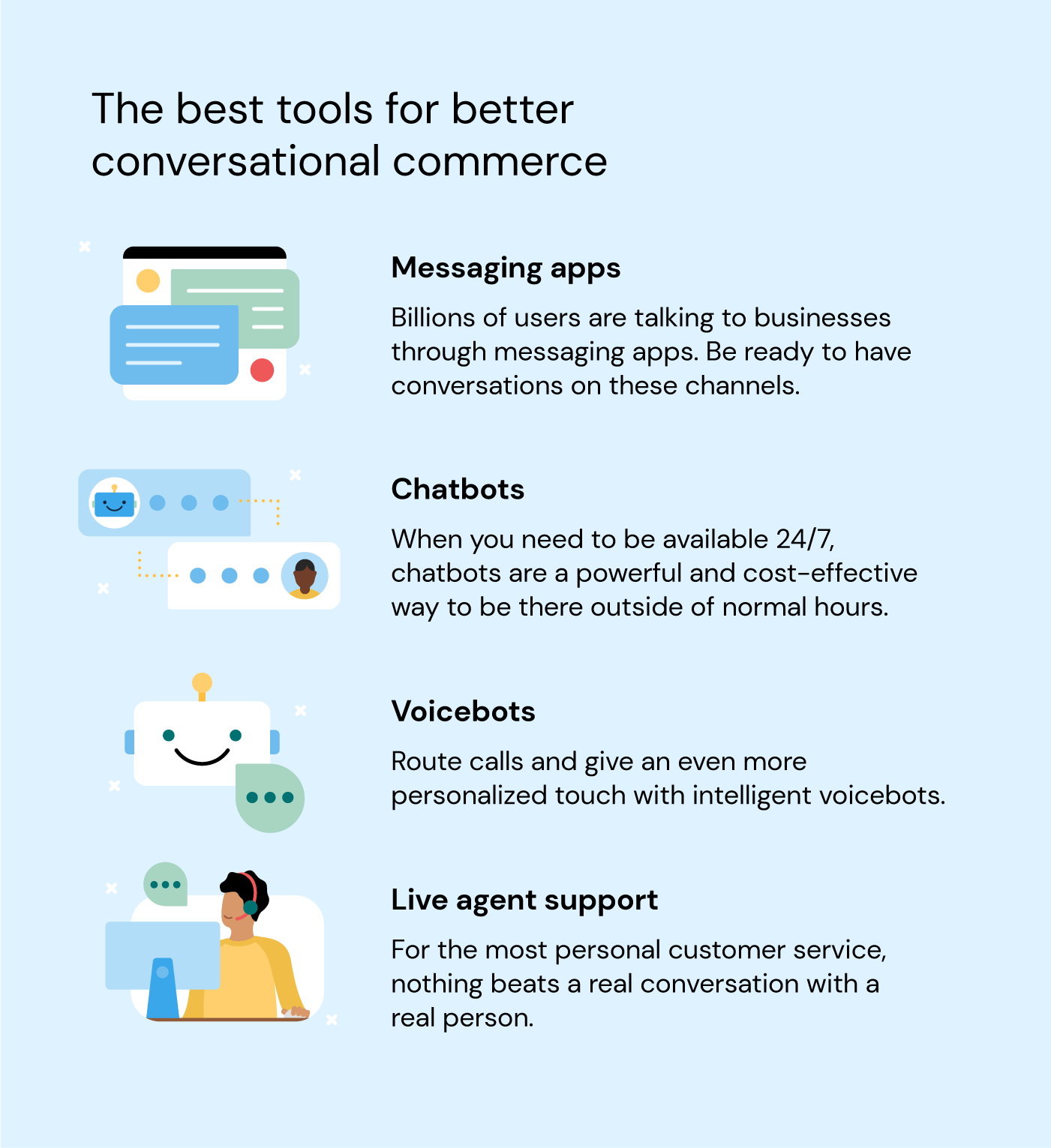In this article:
- How messaging is shifting the market
- Transform the customer journey with conversational commerce
- 7 reasons why you can’t afford to ignore conversational commerce
- 4 tools for better conversations with your customers
- An example of conversational commerce at work
- How to bring conversational commerce to your company
- Ready to have a conversation?
Have you ever been shopping online and had a question about a product? What did you do if you couldn’t find the answer right away? If a chat window or voice assistant didn’t pop up to help, did you stick around or did you shop somewhere else that could help you?
As more retail moves online, 71% of people expect real-time communication with a business. A majority of people (53%) are frustrated when they get a mobile message but can’t reply to it. How companies provide their customers with the two-way conversations they need, when they need it and with the right tools is what makes conversational commerce possible.
So, what is conversational commerce? It’s where online, in-person shopping and messaging apps intersect. It’s when real-time communication between a business and its customers takes place to make a sale.
By using messaging apps, a customer can interact with a business in several ways, including:
- Starting a support request
- Asking questions about products and services
- Getting recommendations based on past purchases
- Checking reviews of products
- Making purchases
For businesses to do all of this, they need a combination of live support, chatbots, and voicebots, while using the popular social messaging channels in your market. By linking together powerful tools, Sinch’s Conversation API lets customers move across their preferred channels seamlessly.
In this article, we’ll drill down on how to start a conversation with your customers, the best ways to earn their trust, improve conversions, and future-proof your communication strategy.
How messaging is shifting the market
There’s no doubt about it: messaging apps are the order of the day. While they might have started as a way for people to talk to their friends and family, these apps have quickly transformed e-commerce.
As businesses have ramped up their online presence, buyers expect the kind of customer service they’d get at a brick and mortar store. They want to be able to visit an online store, check out a product and ask questions, and then make a purchase online.
As the lines between the real world and digital spaces blur, we’re witnessing the birth of hybridization. Unfortunately, a lot of companies aren’t taking full advantage of the benefits of this new system. They’re missing out on potential sales and customer loyalty because they’re unable to find ways to have conversations with their customers across a variety of platforms.
A few challenges businesses face
While no list could cover all of the challenges businesses face in today’s changing marketplace, here are a few of the most common issues:
- Spending a lot of money on ineffective marketing efforts that lead to low engagement. There’s a 96% non-response rate in direct marketing campaigns, for example.
- Trying to keep up with the trends of where and how people are searching for products. We get it - it seems like a new app or social network launches almost every day.
- Trying to get the technology needed to embrace hybridization. Many of the out-of-the-box solutions are extremely complicated, don’t scale, and don’t include the necessary channels.
- The gap between the responses marketing teams think people will have and the responses people actually have. Even armed with the best research, marketing teams can’t plan for and reach out across all channels with equal skill.
How conversational commerce solves those challenges

Because customers might switch between channels, an omnichannel experience that centers on them while making their journey available to your team means customers have a better experience. And the business is able to support its customers more seamlessly by providing a more conversational, while still helpful, feel.
Conversational commerce offers a more personalized, human touch that's been missing from e-commerce. Messaging is at the center of that conversation. The four pillars of conversational commerce are what support efforts to bridge the gap from one-way to two-way conversations.
The 4 pillars of conversational messaging are:
- Connecting with your customers on their favorite channels. Meeting your customers where they are (like on WhatsApp and Facebook Messenger) means better, more personalized service. In fact, Meta and Boston Consulting found that 66% of people have messaged a business.
- Show, don’t tell. People like to get information quickly and nothing does that better than visuals. Including a video can help improve conversions by almost 90%.
- Be a friend. Messaging is as close to face-to-face communication as you can get, so make your conversations as personal and real as possible.
- Create meaningful conversations. Over a billion people message businesses each week on Meta messaging apps alone. Being there for your customers can help create a more direct connection with your brand.
Transform the customer journey with conversational commerce
Conversational commerce helps a business better connect with its clients at every point of the customer journey. To understand how to reach a customer along their journey, it’s good to know its five stages: acquisition, onboarding, engagement, conversion and upselling, and loyalty and service.
1. Acquisition
This is the beginning of the journey. During the acquisition stage, a customer realizes they have a problem they need to solve. When they’re in this stage, they’re gathering information about the problem and its potential solutions.
It’s at this point in the journey that you begin the conversation with the customer. The easiest way to do that isn’t always through marketing, but instead by showing them that you understand the problem they have and know how to fix it.
Conversational commerce application: One way to get a customer into a conversation is through AI-powered ads. A prospective customer can click a link in the ad to be taken to a social messaging channel, like WhatsApp, and that link can open a messaging window. There, they can communicate with a chatbot that has been set up to answer questions people have when they’re beginning their journey.
2. Onboarding
When a customer comes on board, either by making a purchase or signing up for a subscription, you need to reassure them that they made the right choice. You can do that by showing them how your product or service can work through any pain points they might run into.
Conversational commerce application: During this stage, you can provide your customers with access to either live or AI-powered support. Onboarding also gives you plenty of data you can use to further refine the process of bringing a customer in. By analyzing which parts of the onboarding stage people are engaging with, (and by looking at the questions they ask) you can smooth out rough spots while shaping new acquisition strategies.
3. Engagement
Using AI, your business can present featured products or services to customers. Use their favorite channels and rich media elements to grab their attention. During these engagements, present them with new offerings and invite them to ask more questions.
Conversational commerce application: By creating another opportunity for dialogue, you’re keeping customers engaged and interested. Like any good conversation, your company can learn more by listening than by talking. The more questions a customer asks, the more specific your AI can get when recommending a product or service.
4. Conversion and upselling
With today’s technology, a customer can complete the entire process of shopping - from browsing to payment - all within a single chat app or social messaging channel. Taking care of everything in one place removes many of the barriers to purchase. A seamless, intuitive, and fast solution provides opportunities for upselling that won’t feel forced or like a drag on the process.
Conversational commerce application: If customers need last-minute help, you can build solutions to fix their problems right away. If they need more convincing, provide them with social proof to show that others in their situation have chosen your business.
5. Loyalty and service
Because it is much more affordable to retain your current customers than to find new ones, you need to do everything you can to keep them around. The best way to do that is by building better experiences using conversational commerce.
Conversational commerce applications: These may vary but might include regular messages with product recommendations or checking in on purchases, special deals and time-sensitive offers, handling any issues that come up (including fraud alerts), and keeping customers in the loop about their purchases with cart reminders and shipping notifications. Offering support via live chat can also create more loyal customers. In fact, 52% of consumers are more likely to make repeat purchases if a company offers support via live chat.
7 reasons why you can’t afford to ignore conversational commerce

We’ve seen how commerce is changing and how conversations between businesses and customers are more important than ever. Below are a few of the many reasons why your company needs to make conversational commerce a priority.
It makes the customer experience frictionless
Customers should get the same great service and experience on whatever channel they’re using. Analyze where you’re interacting with customers, then find ways to make sure that they can move between channels without starting forcing them to start over. An omnichannel strategy centers on the customer and makes sharing their position within the journey with other team members easier.
Automation saves time and money
Waste is, well, wasteful. Not only does it eat up some of your most important (and most limited) resources - time and money - it creates inefficiencies that punish your customers. Automate the most common processes at the core of your conversational commerce strategy and use chatbots and messaging to keep money in your bank account.
Be “always on” for your customers
With automation and AI, you don’t need live support 24/7, but your customers should still be able to get answers day or night, wherever they are on the planet. With intelligent conversations built in, chatbots can direct people to what they need, including the right support or sales portals.
Being “on” 24/7 is another tool that can help prevent lost opportunities. Say a customer is browsing late at night and they have a question about a product that a chatbot can answer. If your site doesn’t have a chatbot ready to help, is that customer going to come back when you’re open or are they going to move on to a competitor?
Get leads to the right team members quickly
Omnichannel systems allow you to route leads to the proper team members faster and more efficiently than before. A connected strategy also gives your team members information that the customer has already shared with chatbots and other support or sales staff. That means they don’t have to repeat themselves, which puts your agents in a better position to help as soon as the conversation begins.
You’ll have fewer abandoned carts
With the average cart abandonment rate at 70%, anything you can do to lower that number is going to result in more sales. Live chats and chatbots can support customers who are unsure about checking out. Those chatbots can also be set up to incentivize customers with discounts or offer support based on browsing information or previous interactions.
Get better, more useful feedback
Getting valuable feedback in real time from your customers at every step of their journey is a powerful way to make changes based on how real people are using your products. For example, when a customer finishes a purchase, you can ask for their opinion on the process and if there is anything you could do better.
Find new opportunities for upselling
Studies have found that a majority of consumers who’ve experienced personalized upselling felt that it was impactful. When you talk to your customers more, you’ll know how to better serve them. Whether they tell you directly what else they need or you make an educated guess based on their questions or browsing history, these extra opportunities are extremely valuable.
4 tools for better conversations with your customers

Now that we’ve talked about a few of the benefits of having conversations with your customers, let’s take a look at some of the tools designed to make those two-way conversations possible.
Chatbots
AI chatbots let you give automated responses to customers 24/7/365 on your website or any number of messaging platforms. Instead of simply directing customers to contact a live agent during normal business hours, chatbots can be tailored to address nearly any question they have. And if a chatbot runs into a problem it can’t solve, it can pass the customer to live support.
Messaging apps
OTT (over-the-top) messaging is a huge communication channel. In 2021, there were more than 3 billion messaging app users, and that number continues to grow. Using chatbots and live support on messaging apps is more important than ever because they have become one of the most common ways customers interact with businesses. In some parts of the world, messaging is a deeply integrated part of “super apps” like KakaoTalk, LINE, and WeChat that combine everything from shopping to travel in one place.
Voicebots
Much like chatbots, voicebots can guide customers to products and answers. Depending on a customer’s age, where they live, and their place within the sales funnel, they may prefer to communicate by phone or through the voice feature of a messaging app. Voicebots are a great first step to direct customers to the proper department or provide them with support.
Live agent support
Live agents (through chat or voice) provide the human touch that is the cornerstone of any conversation. As great and flexible as chatbots are, there are certain things they can’t do (yet). Having live agents on the other end of text or voice chats should be able to solve all the problems that automated systems can’t.
An example of conversational commerce at work
In an effort to improve its delivery chain, Brazil’s food delivery platform iFood created conversational messages on WhatsApp. The goal of these messages was to increase restaurant sign-ups, hire more delivery drivers, and improve customer service. Thanks to the targeted and conversational nature of these messages, they saw their sales increase 38-fold.
How to bring conversational commerce to your company
Curious about how to take conversations with your customers to the next level? Keep reading for solutions.
Figure out what your company needs to communicate better
Conversational commerce looks different for each business. While most of the tools we’ve talked about can help any business, the unique needs of your customers should guide your strategy and focus. Ask yourself these questions:
- Are you trying to increase conversions?
- Do you want better support that translates to better reviews and boosts loyalty?
- What tools are you missing that would allow you to better connect with your customers?
When you have these answers, you can start deciding what you need to prioritize. There isn’t a single way to create better conversations with your customers, but by focusing on your channels of communication, you’ll be off to a great start.
Implement tools to create opportunities for conversations
Roll out tools for customers (and your agents) to start having conversations about your products. This probably means branching out to new messaging apps, especially if your target market uses them regularly.
Getting the most out of these tools means training chatbots and live agents to prioritize conversation. Figure out where your customers' pain points are and then build a way to ease those difficulties. Automate as much as possible to reduce waste. Some of the most commonly automated features include:
- Shipping notifications
- Fraud alerts
- New products in stock
Measure the success of your efforts
With the latest APIs, you can analyze the data of every conversation as it’s happening. Collecting and comparing metrics will help you further refine the way you implement conversational commerce. The more thoroughly you measure and evaluate what you’ve learned, the more natural and helpful conversations you’ll have with your customers.
Ready to have a conversation?
Sinch has long been leading the way for companies that want to effectively create, manage, and grow a conversational commerce ecosystem. Our customer communications cloud directly powers meaningful conversations on your customers’ favorite channels at every stage of their journey. With offerings that bring communication channels together to form omnichannel systems that center the customer, Sinch is ready to guide and support your conversational commerce journey. Learn more about transforming your customer experience strategy today.



